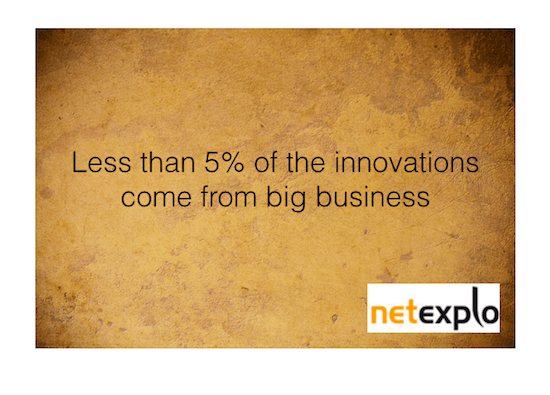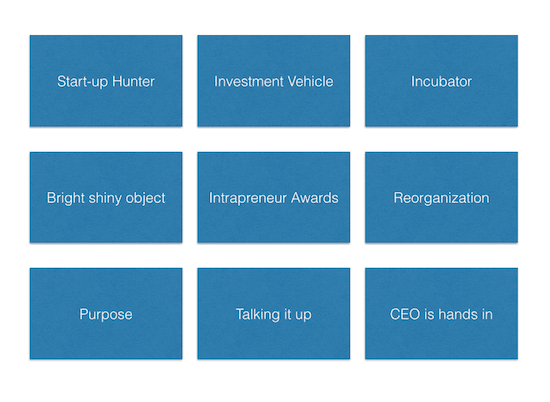The following question is surely on the minds of many top level executives in big business:
How can we embed entrepreneurial flair and an innovative spirit throughout the organization? {Please tweet ♺!}
Companies are fast to cite “Innovation” as strategic. In fact, nearly 40% of companies in a 2009 survey conducted by the Wellcom Agency, cited innovation as a core value. Yet, as the results of the Netexplo Observatory attest, under 5% of the innovations identified yearly come from big business.{♺!} Big business just is not wired for innovation in the same way as the smaller startups that systematically dominate the new tech awards. Instead, innovation is happening everywhere, all the time and from sources that are decidedly unexpected.

The options to imbue more innovation within an organization are myriad. However, the reality will depend on leadership and it will come down to mindset and their modeling the desired behavior. When trying to instill — or perhaps re-ignite — a culture of innovation in today’s fast-paced world, there is a vital need to review how learning happens.{♺!} How have the antennae — keeping watch on competition, innovation and trends — been tuned to the new pace, channels and beacons of change? Learning and innovation must become the responsibility of everyone.{♺!} The success of such a strategic imperative will depend emphatically on the way leadership shows up. To shift an embedded culture of immobility, entrenched silos and a lack of accountability (when it comes to innovation), requires demonstrable changes in behavior and language. Pinning one’s hopes on a “VP of Innovation” is hardly likely to bear fruit if the leadership doesn’t embrace the necessary change within.
A strategic approach
Below is a set of options that are not mutually exclusive. In fact, to get that innovative spirit moving will inevitably take a combination of elements, some being more indispensable and suitable than others, according to the company, industry and intended outcomes. Meanwhile, the core success factor will nonetheless depend on the deep-seated intention of the leadership.

Some of the options above are more lightweight than others. Investing in and integrating startups may be a trendy notion, but the challenge is really in baking into the organization an intrapreneurial flair and innovative spirit. For companies looking to stimulate attention and stir up noise (“marketing” its initiatives), the risk is that it can quickly be viewed internally as superficial posturing.
Developing the innovative spirit
Talent, agility, partnerships, collaborative spirit, incentive programs… Such are the ingredients of a more innovative culture. Each is necessary in some form or other; but, with today’s frenetic pace of change, it will be equally important to be able to decipher and select the right paths. Companies need address strategic issues, such as:
- What kind of eco-system does the company have in place to stay up with what is going on?
- Who in the organization is truly capable of finding and engaging the right partners?
- How do the company’s governance and policies need to be adjusted?
- How to allocate resources intelligently so as not to disturb short-term sales performance?
- To what extent is HR a true business partner?
- How is ongoing learning shared throughout the organization?
- …

Sense of purpose
Companies that have a higher sense of purpose will find it decidedly easier to select the right from the wrong path. There are no prescribed paths for success. Surely, it is hard work. But, when that hard work leads to some greater fulfilment, somehow, the reward is substantially more meaningful and powerful — thus, it is more motivating. On the reverse hand, companies that constantly dictate supreme excellence and perfection — as if they were core human values — will struggle with concepts such as “test & learn” or, worse, “fail & learn.” If you constantly have to experiment, fail and pick yourself up off the floor, it is entirely easier to do so if you know why you are doing it.
At the end of the day, the question to ask is:
What greater good will your innovation serve?
And, it is supremely important that the leadership agrees and feels, personally, the significance of that purpose.
Your thoughts and reactions are welcome!










